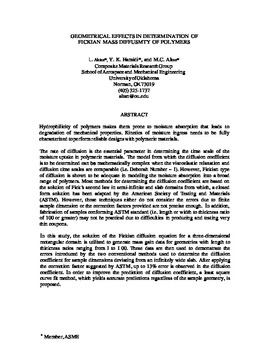| dc.contributor.author | Aktas, L. | |
| dc.contributor.author | Hamidi, Y. K. | |
| dc.contributor.author | Altan, M. C. | |
| dc.date.accessioned | 2016-03-23T23:31:21Z | |
| dc.date.accessioned | 2016-03-30T15:36:22Z | |
| dc.date.available | 2016-03-23T23:31:21Z | |
| dc.date.available | 2016-03-30T15:36:22Z | |
| dc.date.issued | 2003 | |
| dc.identifier.citation | Aktas, L, Hamidi, Y. and Altan, M. C. Geometrical Effects in Determination of Fickian Mass Diffusivity of Polymers, Presented at the 23rd Oklahoma AIAA/ASME Symposium, 2003. | en_US |
| dc.identifier.uri | https://hdl.handle.net/11244/33178 | |
| dc.description.abstract | Hydrophilicity of polymers makes them prone to moisture absorption that leads to degradation of mechanical properties. Kinetics of moisture ingress needs to be fully characterized to perform reliable designs with polymeric materials.
The rate of diffusion is the essential parameter in determining the time scale of the moisture uptake in polymeric materials. The model from which the diffusion coefficient is to be determined can be mathematically complex when the viscoelastic relaxation and diffusion time scales are comparable (i.e. Deborah Number ~ l). However, Fickian type of diffusion is shown to be adequate in modeling the moisture absorption into a broad range of polymers. Most methods for determining the diffusion coefficient are based on the solution of Fick's second law in semi-infinite and slab domains from which, a closed form solution has been adapted by the American Society of Testing and Materials (ASTM). However, those techniques either do not consider the errors due to finite sample dimension or the correction factors provided are not precise enough. In addition, fabrication of samples conforming ASTM standard (i.e. length or width to thickness ratio of 100 or greater) may not be practical due to difficulties in producing and testing very thin coupons.
In this study, the solution of the Fickian diffusion equation for a three-dimensional rectangular domain is utilized to generate mass gain data for geometries with length to thickness ratios ranging from l to I 00. These data are then used to demonstrate the errors introduced by the two conventional methods used to determine the diffusion coefficient for sample dimensions deviating from an infinitely wide slab. After applying the correction factor suggested by ASTM, up to 13% error is observed in the diffusion coefficient. In order to improve the prediction of diffusion coefficient, a least square curve fit method, which yields accurate predictions regardless of the sample geometry, is proposed. | en_US |
| dc.subject | Polymers | en_US |
| dc.subject | Diffusivity | en_US |
| dc.subject | Moisture | en_US |
| dc.title | Geometrical Effects in Determination of Fickian Mass Diffusivity of Polymers | en_US |
| dc.type | Presentation | en_US |
| dc.description.peerreview | Yes | en_US |
| dc.description.peerreviewnotes | Peer reviewed and presented at the 23rd Oklahoma AIAA/ASME Symposium. | en_US |
| ou.group | College of Engineering::School of Aerospace and Mechanical Engineering | en_US |
